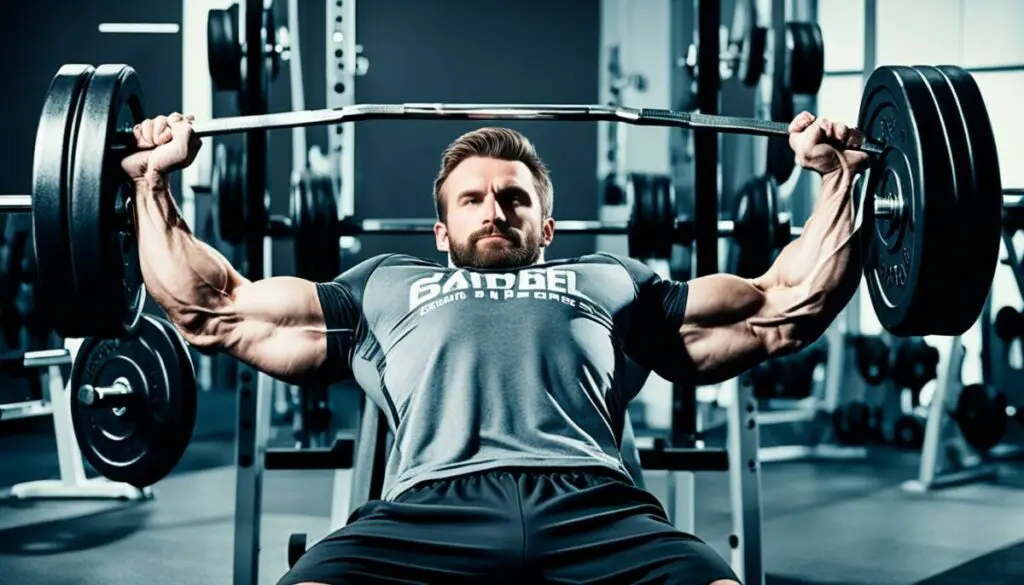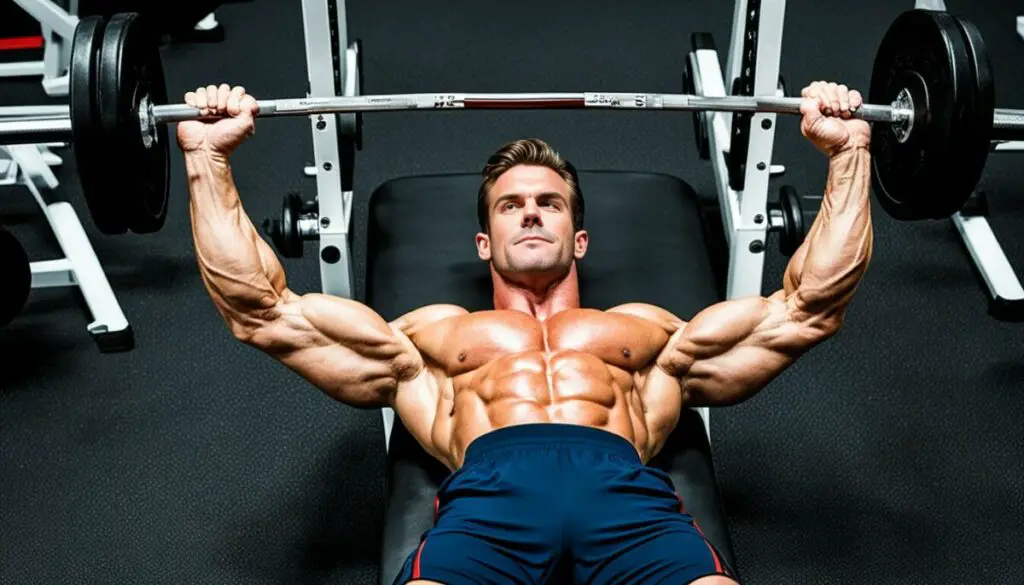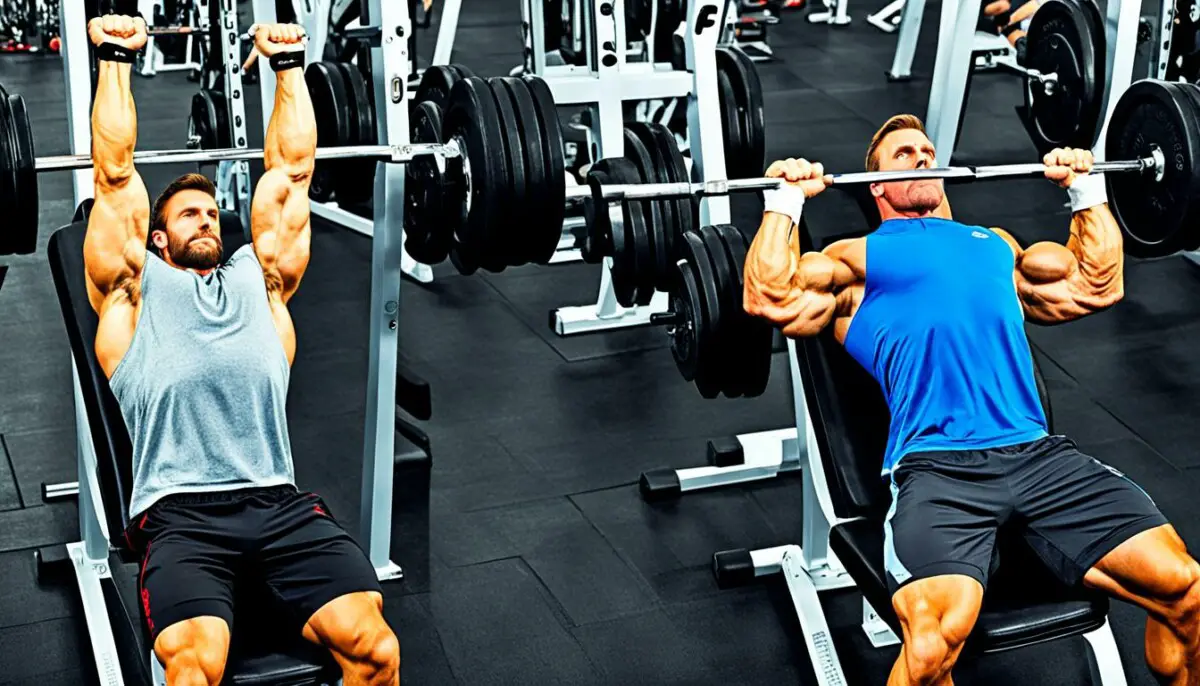Last Updated on 3 months by Francis
When it comes to building a strong and well-defined chest, the barbell bench press and dumbbell bench press are two staple exercises that often come to mind. But which one is better? Let’s explore the differences and benefits of each to help you make an informed decision.
The barbell bench press is a classic compound exercise that involves lifting a weighted barbell while lying on a bench. This exercise allows you to lift heavier weights, making it ideal for building overall strength in the chest, shoulders, and triceps. The stability provided by the barbell also helps maintain a specific bar path, allowing you to focus on pushing with maximum force.
On the other hand, the dumbbell bench press offers a longer range of motion and can target muscular imbalances. By using separate dumbbells for each arm, you can address any discrepancies in strength and ensure balanced development. The increased freedom of movement with dumbbells also helps activate more stabilizer muscles, resulting in a more comprehensive upper body workout.
Both exercises have their strengths and can contribute to your fitness goals. While the barbell bench press is great for building pure strength, the dumbbell bench press offers versatility and can target specific weaknesses. Consider incorporating both into your routine to enjoy the benefits of both worlds.
Contents
Key Takeaways:
- The barbell bench press is ideal for building overall strength in the chest, shoulders, and triceps.
- The dumbbell bench press offers a longer range of motion and can help correct muscular imbalances.
- Both exercises have their strengths, and incorporating both can provide a well-rounded approach to upper body training.
- The barbell bench press allows for heavier weights, while the dumbbell bench press activates more stabilizer muscles.
- Choose the exercise that aligns with your goals and preferences, or consider using both for optimal results.
Differences Between the Barbell and Dumbbell Bench Press

When it comes to chest training, the barbell bench press and the dumbbell bench press are two popular options. While both exercises target the chest, shoulders, and triceps, they have distinct differences that make them unique. Understanding these differences can help you determine which exercise is best suited for your goals and preferences.
Barbell Bench Press
The barbell bench press is a classic compound exercise that involves pushing a weighted barbell away from your chest while lying on a bench. One of the key advantages of the barbell bench press is the ability to move heavier weights compared to the dumbbell press. This additional resistance allows you to build greater overall strength, making it an excellent choice for individuals focused on strength training and powerlifting.
Dumbbell Bench Press
The dumbbell bench press, on the other hand, involves pressing individual dumbbells away from your chest while lying on a bench. Unlike the barbell bench press, the dumbbell press offers a longer range of motion. This increased range of motion provides a greater challenge to stabilizing muscles and activates more muscles in the process. Additionally, the dumbbell press allows for unilateral training, meaning you can address muscular imbalances and target specific weaknesses on each side of your body.
To summarize, the barbell bench press is ideal for those looking to move heavy weights and build overall strength, while the dumbbell bench press is better suited for individuals who want to focus on muscle activation, addressing imbalances, and targeting specific weaknesses.
Similarities Between the Barbell and Dumbbell Bench Press

Although the barbell and dumbbell bench press may seem quite different, there are actually several key similarities between these two exercises. Understanding these similarities can help you make informed decisions about which exercise to include in your workout routine.
Multijoint Movements
Both the barbell bench press and the dumbbell bench press are compound exercises that involve multiple joints and muscle groups. These movements primarily target the chest muscles (pectoralis major), front shoulders (anterior deltoids), and triceps. By engaging multiple muscle groups, both exercises contribute to overall upper body strength and muscle development.
Upper Body Pushing Workouts
Both the barbell and dumbbell bench press are essential for upper body pushing workouts. These exercises are foundational movements that form the basis of many strength training programs. Whether you are a beginner or an advanced lifter, including these compound exercises can help you build a strong and well-developed upper body.
Additionally, both exercises can be adapted to accommodate different fitness levels and goals. Beginners may start with lighter weights or variations that are easier to perform, gradually progressing to heavier weights and more challenging variations as their strength increases.
Let’s take a moment to explore the similarities between the barbell and dumbbell bench press with the help of a table:
| Similarities Between Barbell and Dumbbell Bench Press |
|---|
| Both exercises are compound movements |
| Target the chest, shoulders, and triceps |
| Contribute to overall upper body strength |
| Are essential for upper body pushing workouts |
Now that we’ve explored the similarities between the barbell and dumbbell bench press, let’s move on to examining the differences between these two exercises in the next section.
Barbell Bench Press Vs. Dumbbell Bench Press Technique

The barbell and dumbbell bench press are both effective exercises for targeting the chest, shoulders, and triceps. However, they differ in terms of technique and the type of muscle activation they provide.
The barbell bench press:
- Utilizes both arms simultaneously in a bilateral movement.
- Requires a stable bar path to ensure proper form and prevent injury.
- Offers the ability to lift heavier weights, making it ideal for building overall strength.
The dumbbell bench press:
- Involves each arm working independently in a unilateral movement.
- Allows for a greater range of motion, activating more muscles in the chest, shoulders, and arms.
- Provides more freedom of movement, allowing individuals to address muscular imbalances and target specific weaknesses.
Both exercises contribute to upper body strength and muscle development. However, the barbell bench press emphasizes bilateral strength and stability, while the dumbbell bench press promotes unilateral strength, mobility, and greater muscle activation.
Proper technique is crucial for maximizing the benefits of both exercises. It is recommended to consult a qualified fitness professional or trainer to learn the correct form and execution for each exercise to avoid injury and optimize results.
Benefits of the Barbell Bench Press

The barbell bench press is a highly effective exercise for building upper body strength and enhancing overall muscular development. Incorporating this compound movement into your strength training routine can yield significant benefits and help you reach your fitness goals.
Here are some key advantages of the barbell bench press:
- Increased Upper Body Strength: The barbell bench press allows you to lift heavyweights, challenging your muscles and promoting strength gains. This exercise engages multiple muscle groups, including the chest, shoulders, and triceps, helping you develop a strong and powerful upper body.
- Core Engagement: By performing the barbell bench press, you learn to engage your core muscles to maintain stability and proper form throughout the movement. This not only strengthens your core but also enhances overall body control and balance.
- Specific Bar Path: The barbell bench press requires you to maintain a specific path for the barbell as you lower and lift it. This controlled movement pattern helps develop coordination and precise muscle activation, leading to improved strength gains and muscular development.
- Fundamental Exercise: The barbell bench press is considered a fundamental exercise in strength training and is commonly used by powerlifters and athletes to build upper body strength. It emphasizes the development of the chest muscles, promotes symmetry, and enhances overall upper body aesthetics.
To maximize the benefits of the barbell bench press, it’s important to focus on proper technique, gradually increase weights, and incorporate variations and progressive overload into your training program. Always consult with a qualified fitness professional to ensure proper form and prevent injuries.
Sample Table: Comparison of Barbell Bench Press vs. Dumbbell Bench Press
| Benefits | Barbell Bench Press | Dumbbell Bench Press |
|---|---|---|
| Increased Upper Body Strength | ✅ | ✅ |
| Core Engagement | ✅ | ✅ |
| Specific Bar Path | ✅ | ❌ |
| Development of Chest Muscles | ✅ | ✅ |
| Range of Motion | ❌ | ✅ |
| Muscular Imbalances | ❌ | ✅ |
| Joint Stress | ❌ | ✅ |
Benefits of the Dumbbell Bench Press

The dumbbell bench press is a highly effective exercise for targeting specific weaknesses and correcting muscular imbalances. Unlike the barbell bench press, which requires both arms to move together, the dumbbell press allows for a greater range of motion and independent movement of each arm.
This increased range of motion translates into more muscle activation, as it allows you to fully stretch and contract your chest muscles. By working each side of your body separately, the dumbbell press can help address any imbalances between your left and right sides, ensuring symmetrical development.
Another benefit of the dumbbell bench press is the reduced strain it places on the shoulders. Since each arm works independently, you have more freedom to find a grip width and position that feels comfortable for your individual biomechanics. This can be particularly beneficial for individuals with shoulder issues or joint sensitivities.
If you’re looking to add variety to your upper body workouts, the dumbbell bench press is an excellent choice. It provides an alternative to the traditional barbell press and stimulates your muscles in a slightly different way. By incorporating both exercises into your training routine, you can work your chest from various angles and maximize your overall muscle development.
Whether you’re a beginner or an experienced lifter, the dumbbell bench press is a valuable addition to your upper body workout routine. Its ability to target specific weaknesses, provide a greater range of motion, and reduce shoulder strain makes it an effective and safe exercise choice for individuals seeking well-rounded chest development.
“The dumbbell bench press offers a greater range of motion compared to the traditional barbell press, allowing for increased muscle activation and targeted chest development.”
| Benefits of the Dumbbell Bench Press | Summary |
|---|---|
| Targets specific weaknesses and corrects muscular imbalances | Address and correct any imbalances between your left and right sides, ensuring symmetrical muscle development. |
| Provides a greater range of motion | Allows for a full stretch and contraction of the chest muscles, promoting increased muscle activation. |
| Reduces shoulder strain | Each arm works independently, allowing for a comfortable grip width and position, minimizing shoulder stress. |
| Offers variety in upper body workouts | A great alternative to the barbell press, stimulating the chest from different angles for overall muscle development. |
Barbell Bench Press Variations
When it comes to chest workouts and upper body workouts, the barbell bench press is a staple exercise. But did you know that there are variations of the barbell bench press that can add even more diversity to your training routine?
One popular variation is the incline barbell bench press. This exercise targets the upper chest muscles, helping to sculpt a well-defined and balanced chest. By adjusting the bench angle to about 45 degrees, you shift the focus to the upper chest, providing a different stimulus to your muscles.
| Exercise | Description |
|---|---|
| Incline Barbell Bench Press | This variation is performed by adjusting the bench angle to around 45 degrees. It targets the upper chest muscles, helping to add definition and shape. |
| Decline Barbell Bench Press | This exercise is performed with the bench angled downward, targeting the lower chest muscles. It can help develop strength and size in the lower chest region. |
Another variation to consider is the decline barbell bench press. By adjusting the bench angle to a decline position (around 15-30 degrees), you shift the focus to the lower chest muscles. This variation can help add size and strength to the lower chest region.
Adding these barbell bench press variations to your chest workout routine can help you develop a well-rounded chest and improve overall upper body strength. So why not give them a try and take your training to the next level?
Dumbbell Bench Press Variations
When it comes to chest workouts and upper body workouts, the dumbbell bench press is a versatile exercise that can be modified to target different areas of the chest and add variety to your training routine. Incorporating dumbbell bench press variations can help you break through plateaus, challenge your muscles in new ways, and enhance your overall chest development.
1. Alternating Dumbbell Bench Press
The alternating dumbbell bench press is a great variation to engage your chest muscles individually and improve muscular balance. Start by lying on a flat bench with a dumbbell in each hand, palms facing forward. Instead of pressing both dumbbells up simultaneously, lift one dumbbell at a time while the other stays lowered. This alternating movement allows you to focus on each side of your chest independently, promoting equal strength and development.
2. Kettlebell Bench Press
The kettlebell bench press is another effective variation that adds a unique challenge to your chest workouts. Instead of using dumbbells, you’ll use kettlebells, which have a different weight distribution and shape. The kettlebells require increased stabilization and engagement of your core muscles, making the exercise more dynamic and engaging. This variation targets your chest muscles in a slightly different way compared to traditional dumbbell bench presses, helping to stimulate muscle growth and improve upper body strength.
By incorporating these dumbbell bench press variations into your chest workouts, you can maximize the benefits of the exercise and target specific areas of the chest. The alternating dumbbell bench press allows you to focus on individual muscular imbalances and promote equal development, while the kettlebell bench press adds an extra challenge to your training routine. Experiment with these variations to keep your workouts exciting and continue making progress in your upper body strength and chest development.
Conclusion
The barbell and dumbbell bench press are two highly effective exercises for developing chest strength and overall upper body power. Each exercise offers unique benefits that cater to different fitness goals and individual preferences.
The barbell bench press, known for its ability to handle heavier weights, is ideal for building overall strength. It engages multiple muscle groups, including the chest, shoulders, and triceps, making it a cornerstone of strength training exercises. However, it may not address individual muscular imbalances or offer the full range of motion that some individuals require.
On the other hand, the dumbbell bench press provides a greater range of motion, offering more flexibility for individual needs. It targets specific weaknesses, corrects muscular imbalances, and allows for unilateral training, which can be beneficial for overall muscular development. Additionally, the dumbbell press puts less strain on the shoulders, making it a suitable option for individuals with joint issues.
Ultimately, the best approach is to incorporate both exercises into your training routine. By combining the barbell and dumbbell bench press, you can experience the advantages of heavy weights and overall strength building, while also addressing specific weaknesses and achieving a more well-rounded chest development. Fitness is a journey, and by understanding and utilizing the benefits of both exercises, you can optimize your results and achieve your fitness goals effectively.
FAQ
What are the differences between the barbell and dumbbell bench press?
The barbell bench press allows for heavier weights and is better for building overall strength, while the dumbbell bench press offers more range of motion and can correct muscular imbalances.
What are the similarities between the barbell and dumbbell bench press?
Both exercises are compound movements that target the chest, shoulders, and triceps, making them essential for upper body workouts.
What is the technique difference between the barbell and dumbbell bench press?
The barbell bench press is a bilateral movement, using both arms simultaneously, while the dumbbell bench press is a unilateral movement, with each arm working independently.
What are the benefits of the barbell bench press?
The barbell bench press allows for heavier weights, leading to increased upper body strength. It is a fundamental exercise for building overall strength and is often used by powerlifters.
What are the benefits of the dumbbell bench press?
The dumbbell bench press is effective for correcting muscular imbalances and targeting specific weaknesses. It allows for a greater range of motion and puts less strain on the shoulders.
What are some variations of the barbell bench press?
The incline barbell bench press targets the upper chest, while the decline barbell bench press focuses on the lower chest. These variations can help develop a well-rounded chest and improve overall upper body strength.
What are some variations of the dumbbell bench press?
The alternating dumbbell bench press and kettlebell bench press are effective options for targeting the chest and improving strength. These variations can provide additional challenges and help prevent plateaus in your workouts.
Which exercise is better, barbell or dumbbell bench press?
Choosing between the barbell and dumbbell bench press depends on your goals, preferences, and individual needs. The barbell press is better for building overall strength, while the dumbbell press offers more range of motion and can correct muscular imbalances. Incorporating both exercises into your training routine can provide a well-rounded approach to chest development.








